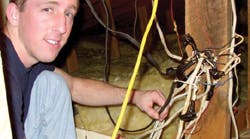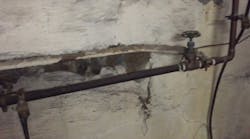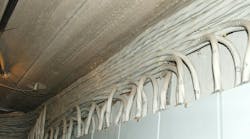As usual, never consider the following commentary associated with these photos as a formal interpretation of the National Electrical Code (NEC). Without criticizing anyone or any product, the following scenarios present us with serious safety questions.
NEST IN THE ATTIC
Chris VanderWoude, owner, Van's Electric, Inc., Franklin, N.C., found this mess in an attic while troubleshooting a residential light fixture that wouldn't work. How many Code violations can you list? I've run out of room on my violation notice. The lack of any type of junction box, no support for the cables, and about a dozen other rules have been violated in this installation (Art. 314, 334, and 300). The “neat and workmanlike” issue is a contender for the worst violation of all.
HOW HOT IS HOT?
Steve Wiggins, an HVAC contractor from Waco, Texas, took a photo of this 10-ton electric heat rooftop package unit to show just how hot those wire nuts can get when the connection is bad. The “drooling” wire connector appears to be hopelessly undersized for the application, based on the exposed strands of the black conductor. Because of different characteristics of dissimilar metals, devices like pressure terminal or pressure splicing connectors and soldering lugs shall be identified for the material of the conductor and shall be properly installed and used (110.14). There also appears to be other evidence of localized overheating, possibly due to an intermittent/failed “indoor” fan. The black wire looks like part of some modification — maybe THHN “building wire” creatively connected to the red “appliance wiring material” — made by an “unqualified person.” The black crusty stuff (bottom left in picture) on the red vinyl conductor supports the theory that gross overheating is the likely culprit.
THEY PLUMP WHEN YOU COOK 'EM
Tom Clements, Miller Blue Ribbon Beef, Swift & Co., Hyrum, Utah, found this split conduit near a steam water separator in his plant. The separator had failed and let steam escape into the cold surrounding air, which in turn condensed vapor in the conduit, thus splitting it open.
There's a good chance the installer forgot to properly seal the raceway. The NEC requires portions of a cable, raceway, or sleeve known to be subjected to different temperatures in places where condensation is known to be a problem to be filled with an approved material to prevent the circulation of warm air to a colder section of the raceway or sleeve. An explosionproof type seal isn't required for this purpose [300.7(A)].
HOW LOW CAN YOU GO?
An employee from Jerry's Electric in Rhode Island submitted this photo. Without applying any of the exceptions, service-drop conductors can't be readily accessible and must comply with the requirements of 230.24(A), which covers clearances for services less than 600V, nominal. When installed above roofs, service drop conductors are required to have a vertical clearance of at least 8 feet above the roof surface. This vertical clearance must also be maintained for a distance of no less than 3 feet in all directions from the edge of the roof.
A service drop is defined in Article 100 as, “The overhead service conductors from the last pole or other aerial support to and including the splices, if any, connecting to the service-entrance conductors at the building or other structure.” See 230.28 for the requirements of using service masts as supports for service-drop conductors.
Found a Code violation? Send your photos to Joe Tedesco at PO Box 130408, Boston, MA 02113 or [email protected].







